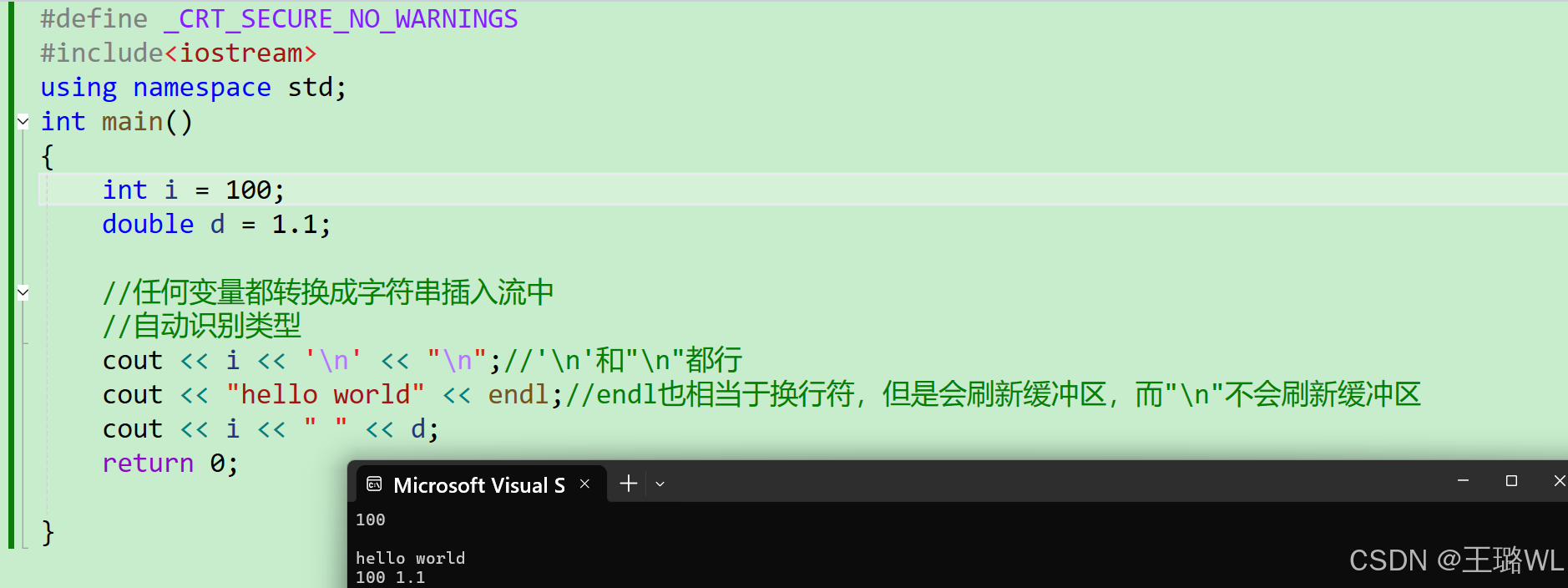C++输⼊&输出
• 是InputOutputStream的缩写,是标准的输⼊、输出流库,定义了标准的输⼊、输出对象。
• std::cin是istream类的对象,它主要⾯向窄字符(narrowcharacters(oftypechar))的标准输⼊流。
• std::cout是ostream类的对象,它主要⾯向窄字符的标准输出流。
• std::endl是操作符,底层实现是⼀个函数,流插⼊输出时,相当于插⼊⼀个换⾏字符加刷新缓冲区。
• <<是流插⼊运算符,>>是流提取运算符。(C语⾔还⽤这两个运算符做位运算左移/右移)
• 使⽤C++输⼊输出更⽅便,不需要像printf/scanf输⼊输出时那样,需要⼿动指定格式,C++的输⼊输出可以⾃动识别变量类型(本质是通过函数重载实现的),其实最重要的是 C++的流能更好的⽀持⾃定义类型对象的输⼊输出。
• IO流涉及类和对象,运算符重载、继承等很多⾯向对象的知识。
• cout/cin/endl等都属于C++标准库,C++标准库都放在⼀个叫std(standard)的命名空间中,所以要通过命名空间的使⽤⽅式去⽤他们。
• ⼀般⽇常练习中我们可以using name space std,实际项⽬开发中不建议using name space std。
• 这⾥我们没有包含<stdio.h>,也可以使⽤printf和scanf,因为包含间接包含了<stdio.h>。vs系列编译器是这样的,其他编译器可能会报错。
#include<iostream>
using namespace std;
int main()
{
int a = 0;
double b = 0.1;
char c = 'x';
cout << a << " " << b << " " << c << endl;
std::cout << a << " " << b << " " << c << std::endl;
scanf("%d%lf", &a, &b);
printf("%d %lf\n", a, b);
// 可以⾃动识别变量的类型
cin >> a;
cin >> b >> c;
cout << a << endl;
cout << b << " " << c << endl;
return 0;
}
#include<iostream>
using namespace std;
int main()
{
// 在io需求⽐较⾼的地⽅,如部分⼤量输⼊的竞赛题中,加上以下3⾏代码
// 可以提⾼C++IO效率
ios_base::sync_with_stdio(false);
cin.tie(nullptr);
cout.tie(nullptr);
return 0;
}
#include<iostream>
using namespace std;
int main()
{
int i = 100;
double d = 1.1;
//任何变量都转换成字符串插入流中
//自动识别类型
cout << i << '\n' << "\n";//'\n'和"\n"都行
cout << "hello world" << endl;//endl也相当于换行符,但是会刷新缓冲区,而"\n"不会刷新缓冲区
cout << i << " " << d;
return 0;
}
运行结果
